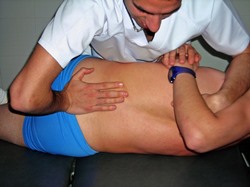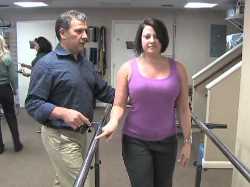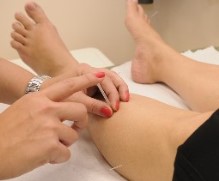How to Pick a Physical Therapist School near San Francisco 94101
 Obtaining a physical therapy degree near San Francisco CA is a critical first step to starting a fulfilling career in the health care field. Physical therapists (PT) help people who have been disabled as a result of injury or illness regain mobility and function. But before they may legally practice and work with the rehabilitation of patients, they need to receive the necessary training and education. A PT must also be licensed in every state, many mandating that the licensee receive a physical therapy degree from an accredited school. So prior to enrolling in a physical therapy school, it’s necessary to investigate those you are considering to make certain they will provide a superior education and comply with your state’s licensing criteria. What you do not want to do is choose a college just because it happens to be the closest to your residence or it has the most affordable tuition. There are other significant qualifications that must be evaluated besides location and cost. But before we cover what those qualifications are and the questions you should be asking, we’ll cover what a physical therapist does and the options for education.
Obtaining a physical therapy degree near San Francisco CA is a critical first step to starting a fulfilling career in the health care field. Physical therapists (PT) help people who have been disabled as a result of injury or illness regain mobility and function. But before they may legally practice and work with the rehabilitation of patients, they need to receive the necessary training and education. A PT must also be licensed in every state, many mandating that the licensee receive a physical therapy degree from an accredited school. So prior to enrolling in a physical therapy school, it’s necessary to investigate those you are considering to make certain they will provide a superior education and comply with your state’s licensing criteria. What you do not want to do is choose a college just because it happens to be the closest to your residence or it has the most affordable tuition. There are other significant qualifications that must be evaluated besides location and cost. But before we cover what those qualifications are and the questions you should be asking, we’ll cover what a physical therapist does and the options for education.
What Does a Physical Therapist Do?
 Physical therapists work in varying locations, including San Francisco CA hospitals, health clinics, assisted living facilities, rehab centers and sports facilities. What the facilities all have in common is that they have the equipment for the diagnosis and rehabilitation treatment of patients. As earlier touched on, physical therapists help people that are struggling with a lack of mobility and frequently pain due to illness or injury. After diagnosing a patient, they develop a program of treatment to deal with the mobility issues and reduce or eradicate any pain. They also try to prevent any advancement of the disability. Although the causes of disability requiring physical therapy are abundant, they include:
Physical therapists work in varying locations, including San Francisco CA hospitals, health clinics, assisted living facilities, rehab centers and sports facilities. What the facilities all have in common is that they have the equipment for the diagnosis and rehabilitation treatment of patients. As earlier touched on, physical therapists help people that are struggling with a lack of mobility and frequently pain due to illness or injury. After diagnosing a patient, they develop a program of treatment to deal with the mobility issues and reduce or eradicate any pain. They also try to prevent any advancement of the disability. Although the causes of disability requiring physical therapy are abundant, they include:
- Osteoporosis and Arthritis
- Motor vehicle accidents
- Head injuries.
- Cardiac arrest.
- Carpal Tunnel Syndrome.
- Fire injuries.
- Hip Replacement.
- Fibromyalgia.
- Cerebral Palsy.
Licensed physical therapists practice in close association with other San Francisco CA medical professionals, including chiropractors, physicians, registered nurses and dentists. They may also manage several physical therapy assistants who work under them assisting with the diagnosis and treatment of their patients. Something to take note of for anyone considering getting into the physical therapy field, it is quite physically demanding. Physical therapists often lift patients and heavy equipment, and kneel, crouch and stand for extended periods of time on a daily basis.
Physical Therapist Degrees Offered
 There are three physical therapy degrees available for individuals to enroll in at the undergraduate and graduate levels. Of these alternatives, the one degree that is attainable to practice as a physical therapist is the doctorate. Undergraduate degrees emphasize either training students to become a physical therapy assistant (PTA) or prepping them to advance to the doctoral level. Below are brief explanations of degrees that are offered in the San Francisco CA area:
There are three physical therapy degrees available for individuals to enroll in at the undergraduate and graduate levels. Of these alternatives, the one degree that is attainable to practice as a physical therapist is the doctorate. Undergraduate degrees emphasize either training students to become a physical therapy assistant (PTA) or prepping them to advance to the doctoral level. Below are brief explanations of degrees that are offered in the San Francisco CA area:
- Associate Degrees prepare students to become physical therapy assistants, or can be used as a stepping stone to a more advanced degree. Candidates must have obtained a high school diploma or equivalent to be accepted for enrollment. The degrees are usually offered by community or junior colleges, and take about 2 years to complete. An internship or other form of clinical training is usually a portion of the program.
- Bachelor’s Degrees are developed as pre-physical therapy training to prep students to progress to the doctoral level. While they are not required to be a candidate for the doctoral program, they are an important initial step to practicing as a PT. Similar to most bachelor’s degrees, they typically take 4 years to complete and commonly include an internship program of at least 500 hours.
- Doctorate Degrees are mandated if you want to become a practicing licensed physical therapist. The degree program must also be accredited by the Commission on Accreditation in Physical Therapy Education (CAPTE). In addition to the bachelor’s degree, the doctoral takes 3 years to complete, making the overall investment of time seven years in most cases. Clinical or practical training is an intregal component along with the substantial classroom and lab instruction. Therefor the fulfillment of an internship is required, not just for graduation but in some states for licensing also.
The Doctor of Physical Therapy (DPT) has replaced the Master’s of Physical Therapy (MPT), which has been eliminated and is no longer offered in the United States. Some licensed physical therapists holding a master’s or even a bachelor’s degree were “grandfathered” in prior to the existing licensing mandate for a doctorate was implemented.
Physical Therapy Online Programs
 Although not as prevalent as the more traditional options, there are some accredited online physical therapist degrees available, more so at the graduate level. Due to the hands-on structure of the training, clinical lab work and internships are incorporated with the online classes. This requires that the student live near the college campus or in proximity of a sponsored internship. Fortunately, the online part of the program may be accessed within the comfort and convenience of the student’s San Francisco CA residence. Online programs are not only partially more accessible, but in a number of cases more economical. Tuition might be somewhat lower than similar on campus alternatives, and expenses for commuting are reduced. And many of the online schools are accredited by the CAPTE, ensuring a quality education. These benefits may make the online alternative the best choice for those students that are dedicated enough to learn at home.
Although not as prevalent as the more traditional options, there are some accredited online physical therapist degrees available, more so at the graduate level. Due to the hands-on structure of the training, clinical lab work and internships are incorporated with the online classes. This requires that the student live near the college campus or in proximity of a sponsored internship. Fortunately, the online part of the program may be accessed within the comfort and convenience of the student’s San Francisco CA residence. Online programs are not only partially more accessible, but in a number of cases more economical. Tuition might be somewhat lower than similar on campus alternatives, and expenses for commuting are reduced. And many of the online schools are accredited by the CAPTE, ensuring a quality education. These benefits may make the online alternative the best choice for those students that are dedicated enough to learn at home.
Questions to Ask Physical Therapist Colleges
At this point you probably have come to decision regarding some of your initial queries, including the type of physical therapy degree you want to attain, where you prefer to attend classes, and how much you can afford to spend for your education. But since there are so many PT schools within the San Francisco CA area and across California, you’ll need to explore other qualifications also so as to further reduce your list of college options. Furthermore, you need to make sure that you pick the program that is best for you. That’s why we have collected a list of important questions that you must ask the physical therapy schools you are thinking about. Ask each of the potential colleges these questions before making an ultimate selection.
Is the Physical Therapist College Accredited? Find out if the programs you are looking at have received accreditation from a national or a regional agency. As previously stated, if you are pursuing a doctoral degree the program must be accredited by the Commission on Accreditation in Physical Therapy Education (CAPTE). If you enroll in an online program, it can also obtain accreditation from the Distance Education and Training Council. It’s important that both the physical therapy school and program you select are accredited, not just the school. Additionally, verify that the accreditation is through a U.S. Department of Education acknowledged accrediting organization. In addition to guaranteeing that you obtain a quality education, accreditation might be required for state licensing and even for securing student loans or financial assistance.
What is the School’s Standing? In addition to accreditation, it’s imperative that the college and program you choose have exceptional reputations within the physical therapist profession. There are multiple ways you can look into a PT school’s reputation, starting with asking for references from employers that they refer their students to. You can also check online rating services and reviews and ask the accrediting agencies for their reviews as well. Get in touch with a few San Francisco CA physical therapist centers or other healthcare facilities that you may have an interest in working for and ask if they can offer any advice about your program selections. It may also be a good idea to check with the California Attorney General and school licensing authority to find out if any complaints have been submitted against the colleges.
What is the School’s Job Placement Percentage? There are a couple of significant statistics that you should know about all of the physical therapist colleges you are looking at. First is their graduation rate. A low rate may suggest that students left because of displeasure with the program, the instructors, or both. After the students have graduated, how many of them are being hired with the assistance of the college’s job placement program, particularly in the San Francisco CA area? If a program has a high job placement rate, it’s an indication that its reputation within the medical care community is good or even exceptional. It also affirms that the college has a wide network of contacts to assist students obtain internships or jobs upon graduation.
Does the School Support Licensing Requirements? It’s imperative that the program you choose provides both superior training and a curriculum that supports the licensing criteria for California or the state where you will be working. In every state a passing score is needed on the National Physical Therapy Examination (NPTE) as well as a degree from an accredited physical therapist college. While licensing requirements differ state by state for PTA and PT graduates, some states require a minimum amount of clinical hours be performed and passing scores on additional tests.
Are Internship Programs Offered? Inquire if the physical therapist schools you are reviewing have associations with San Francisco CA hospitals or clinics for internship programs. Not only are internships an excellent means to receive hands on training in a clinical environment, they are additionally a requirement for most PT programs and state licensing. As an ancillary benefit, they can help graduates and students establish professional relationships in the San Francisco medical community and help with job placement after licensing.
How Big are the Classes ? Unless you are the type of student that prefers to sit way in the back of the classroom or hide in the crowd, you will likely prefer a small class size. Smaller classes enable more individual participation and personalized instruction. Ask the physical therapy colleges you are considering what the typical student to teacher ratio is for their classes. If practical you may want to sit in on one or more classes before making your ultimate determination. This will also give you an opportunity to speak with a few of the students and instructors to get their perspectives regarding the pharmacy tech program as well.
Where is the School Located? For a number of students, the physical therapy school they decide on will need to be within commuting distance of their San Francisco CA residence. Individuals who have decided to attend classes online obviously will not have to concern themselves with the location of the campus. However, the availability of local internships will be of importance. One thing to keep in mind is that if you choose to enroll in a program that is out of state or perhaps out of your local area, you might have to pay a higher tuition. State colleges commonly charge higher tuitions for out of state residents. And community colleges generally charge a higher tuition for those students that live outside of their districts.
Is Financial Help Provided? The majority of DPT colleges supply some form of financial aid to their prospective students. Ask if the schools you are examining have a financial assistance office and find out what kind of assistance is obtainable. They at least should help in securing a student loan or any grants you might be eligible for. A number of physical therapist colleges provide scholarships, while others provide work programs. So before you eliminate a college because the tuition is too expensive, find out what financial assistance may be available.
Can the College Accommodate your Schedule? And finally you need to confirm that the physical therapy program you ultimately pick can provide the class schedule you need. This is particularly important if you choose to continue working while you attend classes. If you need to schedule evening or weekend classes in the San Francisco CA area, check that they are available. If you can only attend part-time, verify if that is an alternative and how many credit hours or courses you would have to carry. Also, ask what the procedure is for making up any classes that you may miss as a result of illness, work or family obligations.
Earning Your Physical Therapy Degree near San Francisco California?
If you are planning on attending a Physical Therapy School in the San Francisco CA area, the following information may prove to be both interesting and educational regarding the location of your future Alma Mater.
San Francisco
San Francisco (SF; /ˌsæn frənˈsɪskoʊ, fræn-/; Spanish for 'Saint Francis'; Spanish: [ˈsãɱ fɾãnˈsisko]), officially the City and County of San Francisco, is the cultural, commercial, and financial center of Northern California. San Francisco is the 13th most populous city in the United States, and the 4th most populous in California, with 884,363 residents as of 2017.[18] It covers an area of about 46.89 square miles (121.4 km2),[19] mostly at the north end of the San Francisco Peninsula in the San Francisco Bay Area, making it the second most densely populated large US city, and the fifth most densely populated U.S. county, behind only four of the five New York City boroughs. San Francisco is also part of the fifth most populous primary statistical area in the United States, the San Jose–San Francisco–Oakland, CA Combined Statistical Area (8.8 million residents).
As of 2017, it was the 7th highest-income county in the United States, with a per capita personal income of $119,868.[20] The San Francisco CSA was the country's 3rd largest urban economy as of 2017, with a GDP of $878 billion.[21] Of the 574 primary statistical areas in the US, the San Francisco CSA had the highest GDP per capita in 2017, at $99,347 per capita.[21] San Francisco was ranked 14th in the world and third in the United States on the Global Financial Centres Index as of September 2018.[22]
San Francisco was founded on June 29, 1776, when colonists from Spain established Presidio of San Francisco at the Golden Gate and Mission San Francisco de Asís a few miles away, all named for St. Francis of Assisi.[2] The California Gold Rush of 1849 brought rapid growth, making it the largest city on the West Coast at the time. San Francisco became a consolidated city-county in 1856.[23] San Francisco's status as the West Coast's largest city peaked between 1870 and 1900, when around 25% of California's population resided in the city.[24] After three-quarters of the city was destroyed by the 1906 earthquake and fire,[25] San Francisco was quickly rebuilt, hosting the Panama-Pacific International Exposition nine years later. In World War II, San Francisco was a major port of embarkation for service members shipping out to the Pacific Theater.[26] It then became the birthplace of the United Nations in 1945.[27][28][29] After the war, the confluence of returning servicemen, significant immigration, liberalizing attitudes, along with the rise of the "hippie" counterculture, the Sexual Revolution, the Peace Movement growing from opposition to United States involvement in the Vietnam War, and other factors led to the Summer of Love and the gay rights movement, cementing San Francisco as a center of liberal activism in the United States. Politically, the city votes strongly along liberal Democratic Party lines.
Choose the Right Physical Therapy Degree Program near San Francisco CA
Picking the ideal physical therapist school is a necessary first decision you have to make to begin a rewarding career in the health care profession. As we have covered in this article, the DPT or PT degree program and college you pick should both have excellent reputations and be accredited. However there are additional important questions that you should ask concerning your college of choice also. As you begin your search for a physical therapy school, keep in mind that many factors will guide you to your final decision. You might want to go to different colleges to view their facilities and speak with current DPT students. While there, ask yourself this important question: will this college help me achieve my goal of becoming a licensed practicing physical therapist? By adhering to our list of additional questions, you will have the ability to narrow down the field so you can make the best choice. And with the proper education and training, you can accomplish your dream to become a licensed physical therapist in San Francisco CA.
A Few More Interesting Locations in California
Business Results 1 - 10 of 1500












